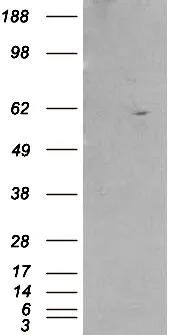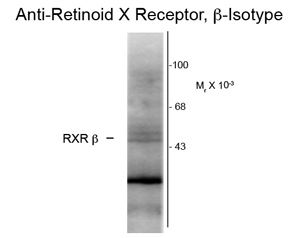
WB analysis of A431 lysate using GTX89670 Retinoid X Receptor beta antibody, Internal. Dilution : 1microg/ml Loading : 35microg protein in RIPA buffer
Retinoid X Receptor beta antibody, Internal
GTX89670
Overview
- SupplierGeneTex
- Product NameRetinoid X Receptor beta antibody, Internal
- Delivery Days Customer7
- Application Supplier NoteWB: 1-3microg/ml. *Optimal dilutions/concentrations should be determined by the researcher.Not tested in other applications.
- ApplicationsWestern Blot
- CertificationResearch Use Only
- ClonalityPolyclonal
- Concentration0.50 mg/ml
- ConjugateUnconjugated
- Gene ID6257
- Target nameRXRB
- Target descriptionretinoid X receptor beta
- Target synonymsDAUDI6; H-2RIIBP; MHC class I promoter binding protein; NR2B2; nuclear receptor subfamily 2 group B member 2; RCoR-1; retinoic acid receptor RXR-beta
- HostGoat
- IsotypeIgG
- Protein IDP28702
- Protein NameRetinoic acid receptor RXR-beta
- Scientific DescriptionThis gene encodes a member of the retinoid X receptor (RXR) family of nuclear receptors which are involved in mediating the effects of retinoic acid (RA). The encoded protein forms homodimers with the retinoic acid, thyroid hormone, and vitamin D receptors, increasing both DNA binding and transcriptional function on their respective response elements. This gene lies within the major histocompatibility complex (MHC) class II region on chromosome 6. Alternatively spliced transcript variants encoding multiple isoforms have been observed for this gene. [provided by RefSeq, Jul 2012]
- Storage Instruction-20°C or -80°C,2°C to 8°C
- UNSPSC12352203
References
- Pigment epithelium-derived factor (PEDF) promotes tumor cell death by inducing macrophage membrane tumor necrosis factor-related apoptosis-inducing ligand (TRAIL). Ho TC et al., 2011 Oct 14, J Biol ChemRead more







